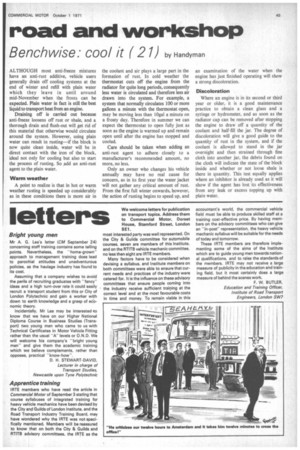road and workshop
Page 47

If you've noticed an error in this article please click here to report it so we can fix it.
Benchwise: coo/it ( 21) by Handyman ALTHOUGH most anti-freeze mixtures have an anti-rust additive, vehicle users generally drain off cooling systems at the end of winter and refill with plain water which they leave in until around mid-November when the frosts can be expected. Plain water in fact is still the best liquid to transport heat from an engine.
Draining off is carried out because anti-freeze loosens off rust or shale, and a thorough drain and flush-out will get rid of this material that otherwise would circulate around the system. However, using plain water can result in rusting—if the block is now quite clean inside, water will be in direct contact with the iron of the block, ideal not only for cooling but also to start the process of rusting. So Add an anti-rust agent to the plain water.
Warm weather
A point to realize is that in hot or warm weather rusting is speeded up considerably as in these conditions there is more air in
the coolant and air plays a large part in the formation of rust. In cold weather the thermostat cuts off the engine from the radiator for quite long periods, consequently less water is circulated and therefore less air drawn into the system. For example, a system that normally circulates 100 or more gallons a minute with the thermostat open, may be moving less than 10gal a minute on a frosty day. Therefore in summer we can expect the thermostat to open fully just as soon as the engine is warmed up and remain open until after the engine has stopped and cooled.
Care should be taken when adding an anti-rust agent to adhere closely to a manufacturer's recommended amount, no more, no less.
Only an owner who changes his vehicle annually may have no real cause for concern, as in its first year the water jacket will not gather any critical amount of rust. From the first full winter onwards, however, the action of rusting begins to speed up, and an examination of the water when the engine has just finished operating will show a strong discoloration.
Discoloration Where an engine is in its second or third year or older, it is a good maintenance practice to obtain a clean glass and a syringe or hydrometer, and as soon as the radiator cap can be removed after stopping the engine to draw off a quantity of the coolant and half-fill the jar. The degree of discoloration will give a good guide to the quantity of rust in the system, and if the coolant is allow,ed to stand in the jar overnight and then strained through fine cloth into another jar, the debris found on the cloth will indicate the state of the block inside and whether or not loose shale is there in quantity. This test equally applies where an inhibitor is already used as it will show if the agent has lost its effectiveness from any leak or excess topping up with plain water.


















































































































